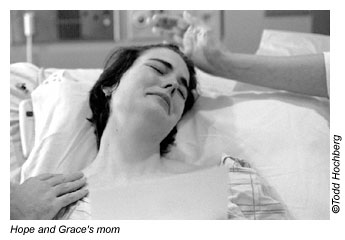| |
|
Bereavement Photography, continued
NF: I don't know how you felt about death before you started this project, but I wonder if your views have changed. I ask that question because my grandmother died last year and my father, who had always been uncomfortable and afraid of death, ended up being with her at the end and saw the whole process of life actually leaving her. It changed him. I think it took him by surprise how OK it was.
 TH: In certain respects I was like most people, and tried to avoid death. I avoided discussing it. I didn't like going to funerals. It was scary. So this work was an opportunity. During that first occasion, which I described earlier, I had an experience like your dad did. For me it wasn't a personal loss, but it did take me by surprise. I watched the family holding their dying baby, and I watched him die. And it was... not... strangely, it was not scary. It was different. It was excruciatingly sad but also as significant and spiritual as birth. So, coming out of that, through the work I've been doing, yes, I am changed. I'd like to think that I'm not afraid of my own mortality, but I don't know. I'm certainly open and interested in supporting others who are dying or grieving. When I have an opportunity to attend a wake or funeral, I don't shy away, I actually go voluntarily. I see the value of ritual: as a part of dealing with death. I'm reminded to value my life and others who are dear to me.... and that's come about a lot because of my experiences with these families. Each breath I take is a gift. TH: In certain respects I was like most people, and tried to avoid death. I avoided discussing it. I didn't like going to funerals. It was scary. So this work was an opportunity. During that first occasion, which I described earlier, I had an experience like your dad did. For me it wasn't a personal loss, but it did take me by surprise. I watched the family holding their dying baby, and I watched him die. And it was... not... strangely, it was not scary. It was different. It was excruciatingly sad but also as significant and spiritual as birth. So, coming out of that, through the work I've been doing, yes, I am changed. I'd like to think that I'm not afraid of my own mortality, but I don't know. I'm certainly open and interested in supporting others who are dying or grieving. When I have an opportunity to attend a wake or funeral, I don't shy away, I actually go voluntarily. I see the value of ritual: as a part of dealing with death. I'm reminded to value my life and others who are dear to me.... and that's come about a lot because of my experiences with these families. Each breath I take is a gift.
NF: Does this project take a toll on you? Not everyone can do this work - in fact I think very few people could do this work.
TH: These situations are laden with intense feelings, stirring me deeply. I choose to be emotionally involved, the pictures are more meaningful for it -- but it also costs me. I don't always meet people before I photograph them with their babies, but on a particular occasion that I want to tell you about, I did meet the couple ahead of time. They were told that their baby would likely not survive long after birth, and mom was very interested in doing whatever she could to embrace the time she had. She got in touch with me. I witnessed the birth and their baby girl lived 17 hours. Following the C-section, mom was lying with the surgical drape still up, adoring and grieving as dad held their daughter beside mom's face. Then nurses needed to take the baby away to baptize and monitor her, dad following the O.R. staff across the room. Here was the mother, not able to see, not able to be with her baby, not able to be close to her and see what was happening. I'm standing there, torn between photographing the baby and dad or staying with the mother in her tear-filled anguish. At one point I just put my cameras down and cradled the mother's head in my hands so she could see her baby. And it was terribly frustrating because I wanted to make pictures; that was my reason for being there. But I also felt a greater need to be there for her.
Days later, they invited me to the graveside service and I photographed. It was very emotional, and I realized how intense the week had been for me -- and yet I wasn't really a part of the family. After the service, the extended family was going back to the couples' home as people do after funerals. Folks were driving off and I was sitting in my car, feeling drained and really sad. I had my hand on my head, just, you know... (sigh)... and suddenly I see the couple's car backing up and dad gets out and comes over to me and asks, "Why don't you come back over to the house?" We hadn't talked about my doing this beforehand and I hadn't assumed anything. As much as family needs the rituals and to have support at home afterwards, it helped me as well to be there to process my feelings. I deliberately left my cameras in my car. So, the connections I make with families and caregivers mediates my sadness some.
Next page: "As long as I have a passion for it, and the spiritual connection is there, I'll keep photographing"
|
|
